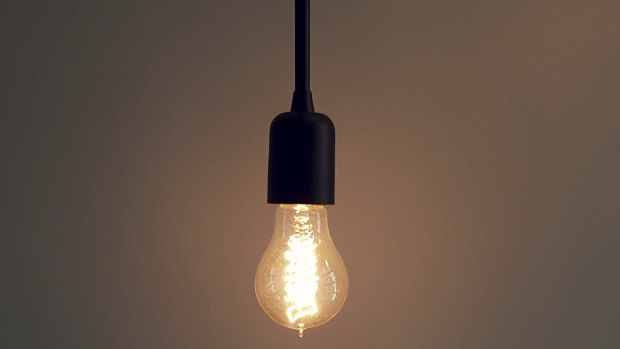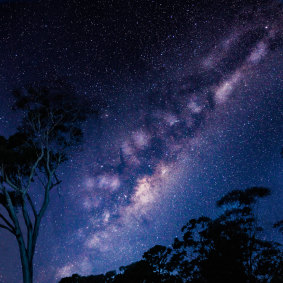- National
- ACT
This was published 5 years ago
Opinion
Turn off the lights and just look up
By Ian Warden
How one would love to have a dollar (better still a golden doubloon) for every time one is hearing the expression “keep the lights on” during the current debate about the NEG (the National Energy Guarantee).
The previous spike in uses of the expression came in 2016 when shameless conservative politicians and fossil fuel entrepreneurs exploited South Australia’s tornado-caused blackout. The shameless accused that then SA premier Jay Weatherill and his government, in their ideological commitment to green and trendy renewables (as opposed to dear old reliable coal) had failed to “keep the lights on” in their state.

There comes a reminder this week of how electric light and electricity per se are very mixed blessings.Credit: Fairfax Media
But there comes a reminder this week, this intense week of NEG debate, of how electric light and electricity per se are very mixed blessings. For this week up there has popped in the online Aeon magazine Professor Richard G ‘Bugs’ Stevens’ challenging and fact-packed essay How the marvel of electric light became a global blight to health.
The cerebral ‘Bugs’ is a professor of community medicine and health care in the School of Medicine at the University of Connecticut. Here is a glimpse of what is worrying him.
“Evidence suggests that … virtually all aspects of health and wellbeing are dependent to one extent or another on a synchronised circadian rhythmicity, with a natural cycle of bright days and dark nights.
“Putting a finer point on the risk is the 2016 New World Atlas of Artificial Night Sky Brightness. The atlas uses data from NASA’s Suomi National Polar-orbiting Partnership satellite to estimate skyglow across the globe. The images in the atlas are either dazzling or horrifying, depending on how you look at it. In its coloured maps of cities and countries, using brighter colours to show greater skyglow, Europe and North America appear ablaze.
“According to the atlas, [because of electric lighting’s skyglow] the Milky Way cannot be seen at night by one-third of humans. In Europe, it’s not visible to 60 per cent of people, and in North America, it’s a whopping 80 per cent.”

The Milky Way cannot be seen at night by one-third of humans.Credit: Fairfax Media.
Yes, we are so blessed by spectacular night skies in Canberra. There are reliable reports of Japanese exchange students from great skyglowing cities marvelling at Canberra’s star-spangled firmament. How these visitors envy us our circadian rhythmicity. I used to think that there was something unique about the splendour of the night sky above my neighbourhood of Canberra’s suburban Woden but now I realise that it is thanks to the quaint old street lighting of my Garran/Hughes neighbourhood. There, faintly glowing amber globes rest atop stubby, artistic little concrete poles barely taller than me and there is no skyglow to speak of, enabling our local firmament to strut its sparkling stuff.
I walk my dog at night, ogling the stars and glad that I know a little Shakespeare, so to have the bard’s plausible explanation of what the stars are. In Romeo and Juliet, dear Juliet, fiendishly smart for a 13-year old, explains the stars thus:
Come, gentle night, come, loving, black-browed night
Give me my Romeo. And when I shall die
Take him and cut him out in little stars
And he will make the face of heaven so fine
That all the world will be in love with night
And pay no worship to the garish sun.
If Professor Stevens’ deep reservations about the so-called “marvel” of electric light lit up receptive areas of my mind, it is in part because I have fond feelings about gaslight. I knew it and loved it.
My first childhood home, in the 1950s, was in a row of picturesquely primitive cottages yet to receive the boon of electricity. Our cottages were not so much lit, as romantically half-lit by gaslight.
Meanwhile, some streets of the town also were still gaslit. At twilight lamplighters would bowl up to lamp-posts on their bicycles (were they truly penny-farthing bicycles or is it just my memory playing tricks?) and light these streetlights with tapers.
There was a poetic softness about the illumination given by gas lighting and a poetic mystery about the shadows gas lighting created and cast. But vulgar electric light drove the shadows away, forever.
When in 1955 we moved to a home that was electrically lit, I would put an urchin finger on the home’s switches and switch the lights on and off in awe and wonder. Somehow, thanks to this privileged Dickensian start in life, I have never felt any sense of entitlement to electric light.
This enables me to stand a little aloof from the NEG debate, to wonder why one would ever judge a government on something so trivial as its ability to keep the lights blazing absolutely all the time.
Vastly more important measures of a government include: does it have a socialist soul; is it incorruptible; does it look after its disadvantaged and homeless; is it welcoming of refugees; does it embrace such pathbreaking 21st century wonders as light rail public transport? These are the sorts of things that really matter.
The lights went out in Adelaide on September 28, 2016 for only a trifling six hours. Surely some grateful Adelaideians took the heaven-sent opportunity, skyglow’s tyranny removed for the moment, to ogle their night sky? Did they marvel at the billions of glittering tinsel-remnants of tragic Juliet’s tragic lover?